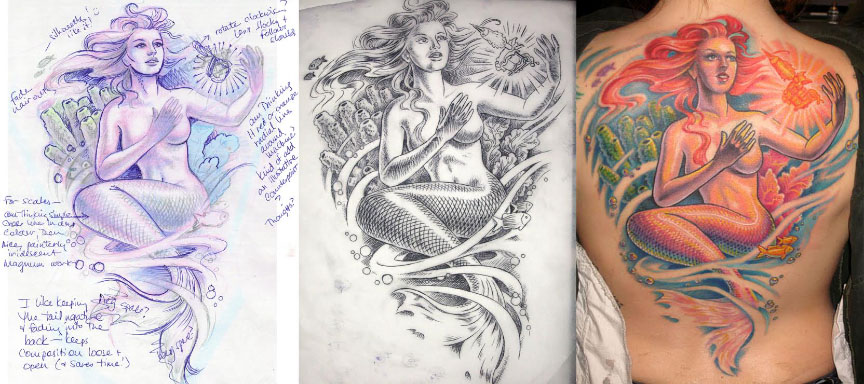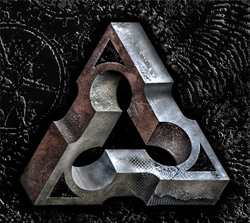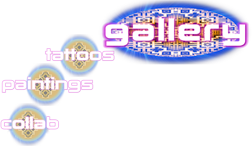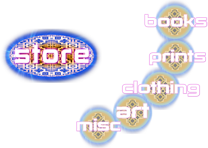Q, from Robert: Hey Guy, I know you've done a lot of collaborations with other artists like Paul Booth and Jack Rudy. I work in a shop with some other pretty decent artists and we're starting to talk about collaborating. I figured you'd be the man to ask: How do we do this right? I've seen a couple pretty bad collaborations so I know it's not all fun and games. Any tips to working with other artists successfully?
A, Hey Robert, thanks for asking- I've been waiting for someone to ask, as it's one of my favorite subjects. And you are right, I've heard a few horror stories, but all the really good collaborations I've seen (or been involved in) have a few things in common.
First, there's a big sense of mutual respect. Both parties are interested in exploring the other's art world a bit, and is curious to see how the styles will blend. So it can't be a contest, with one party or the other trying to dominate the way the piece looks. The whole point is to meet in the middle, blend the two styles together into something that can only happen in the collaborative process.
We speak often of a "third artist" in the room, an artist who is only around when those two particular artists are working together. So there have briefly been Booth/Aitchison and Rudy/Aitchison hybrid artists doing tattoos. the resulting projects are always unique. Part of the way to make it succeed is to embrace the best parts of what you each do. For example, in a recent sleeve project I did with Jeff Gogue, we did a layout including some waves, some rocks, and a samurai crab. Since Jeff already specializes in waves, he did more work than I did on the water in the piece, while I did most of the rocks, since I already specialize in organic effects. Then we had a more or less fifty/fifty blend of participation on the crab, which is a subject that we are both drawn to- Jeff with his flowing, large-scale illustrative approach, and me with my graphically maximal organic take on things.
By the end of the project, we will both have worked on all parts of the piece. With the waves, I did a bit of the initial layout and movement, and toward the end of our second session I expect to do a bit of fine rendering throughout. Jeff will do more shading and coloring on the rocks, because we don't want the effect to look just like regular old Aitchison textures, we want something new that makes use of both of our approaches. And part of the success of the whole thing is based on the fact that we are fans of each other's work.
Second, there needs to be communication, and plenty of it. This begins with rough sketches by both artists that are then talked over before a composite sketch is made based on the favorite parts of the rough ones. Throughout this process discussion is going on about how to approach the piece, what the goals of it are. If it's being passed back and forth online, at each stage there is an opportunity for comparing notes. Whichever artist worked on the drawing last, tell the other artist what you are thinking when you pass the drawing their way.
Some things are especially important to communicate about in the beginning. For starters, which parts of the tattoo are going to be dark, and which parts light? Where will you be using the heavy blacks, and where will you be keeping the piece more open? This needs to be talked about or you run the risk of the piece becoming too dark or dense. Lighting is another good one to talk about- is there a directional light source? Which way is the light hitting the design, so the shading can be done in a way that works and is consistent through the whole piece? Decide this in the beginning and the piece is bound to be more readable in the end.
Third, I think that any good collaboration is going to be a good mix of both artists- there shouldn't be parts that one artist did and parts that the other did; ideally, what you should be aiming for is to get that "third artist" in the room by mixing it up as much as possible.
So after you've both done some roughs and have talked them over, one of you will need to do the first pass on the master sketch, which will combine the best parts of the rough ones. Then the other artist makes a pass over that sketch, either by placing tracing paper over it or by making a very light inkjet print of it and drawing over the first pass, changing whatever parts they want and keeping other parts unchanged. The finished second pass will embody aspects of both artist's styles all mixed into a unified composition.

Then it's up to both of you what steps to take next, whether to proceed directly to skin or to take turns doing shading and color in the drawing. The more of this is worked out in advance, the better- it's insurance against things going wrong on skin, and will give you a chance at a final conversation about it after the drawing is finished and before the piece is started. Once tattooing begins, make a point of trading places at least once during each session so you both get a chance to work all parts of the tattoo. If a question comes up, ask it. If a thought pops into your head, bring it up. Make a music mix of both of your favorite tunes, then have at it.
Finally, a few suggestions for making the tattooing easier. If you both plan on tattooing at once, use small chairs if you can- you will be pressed for space. Working at the same time can be intense for the client but in many cases they find that it's quite bearable. Don't start at exactly the same time- have one artist start first, give it a minute or two, then the other artist starts. If the client feels like they are being electrically shocked, which happens in rare cases, one of the artists needs to reverse their clipcord.
Wipe gently, or time your wiping to a moment when the other artist is pausing. Overall, be aware of how you handle the client and how you move their body parts- it will effect the other artist as well. If you need to do anything that may move or wiggle the client, ask the other artist first. You will quickly develop a sense of collaborative etiquette that makes it possible for you to smoothly both work at once.
As far as finding clients for collab projects goes, we've found that to be easier and easier. Put the word out that you and the other artist are looking to collaborate, and see who takes interest. You may need to do a few collab drawings with that artist and post them or hang them up in the studio before you get any takers, but if both artists already have established clients, it usually isn't too difficult to find takers for collaborative projects. This has resulted in some great and unique tattoos happening in recent years.























